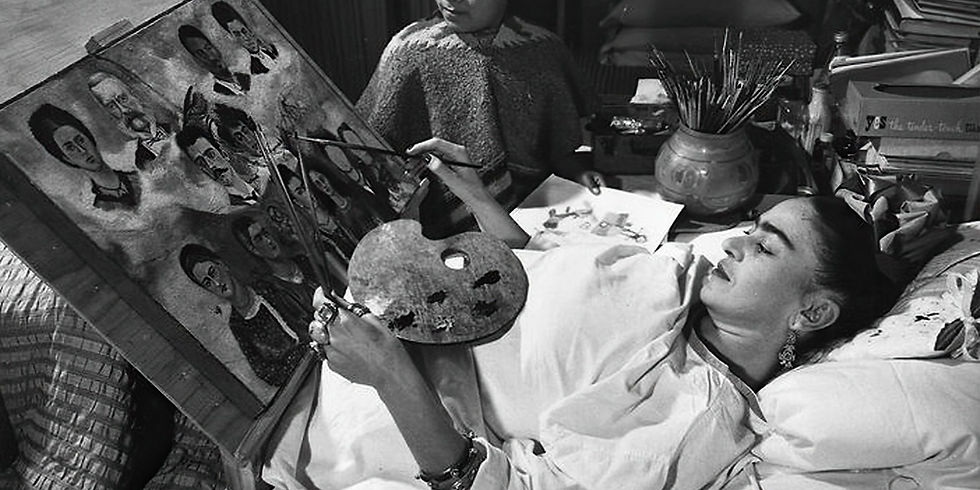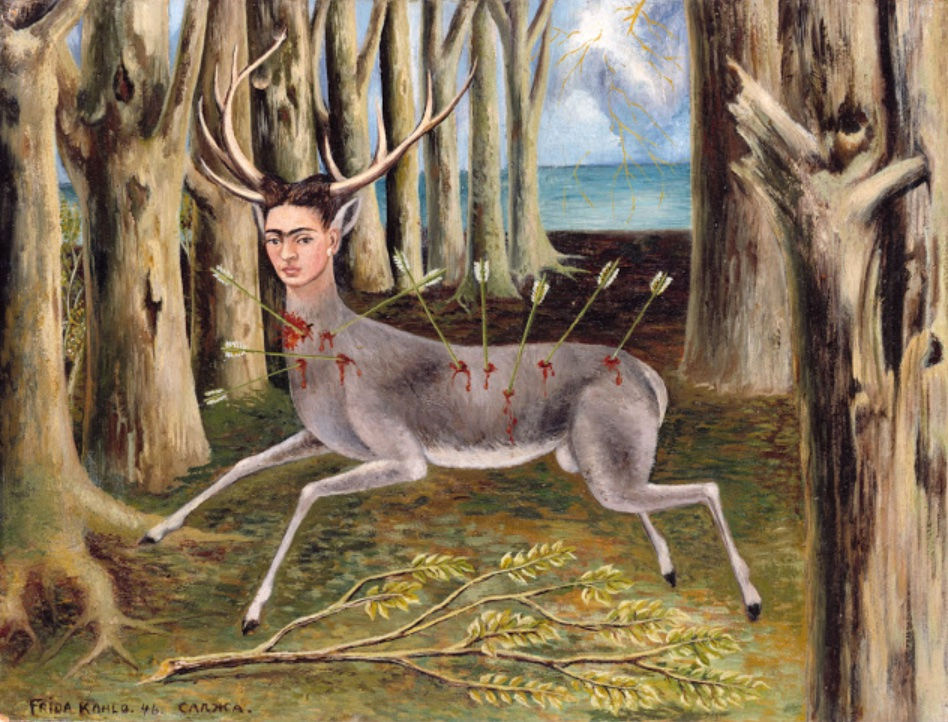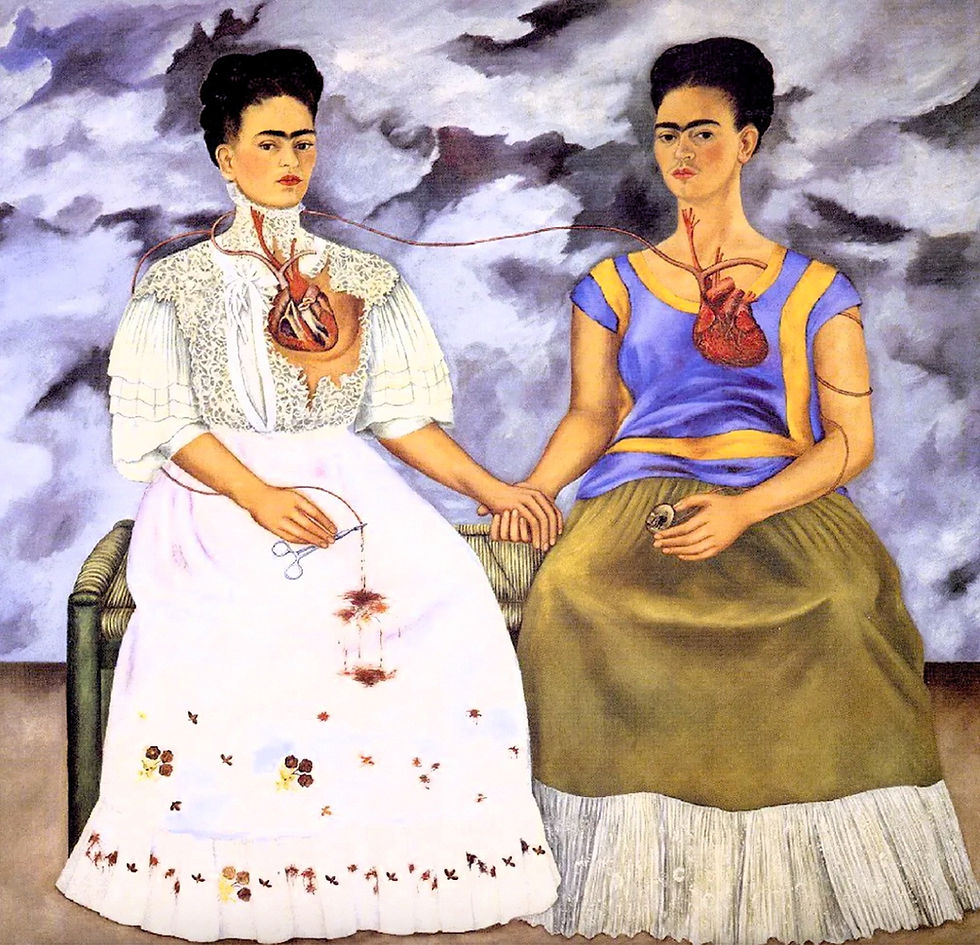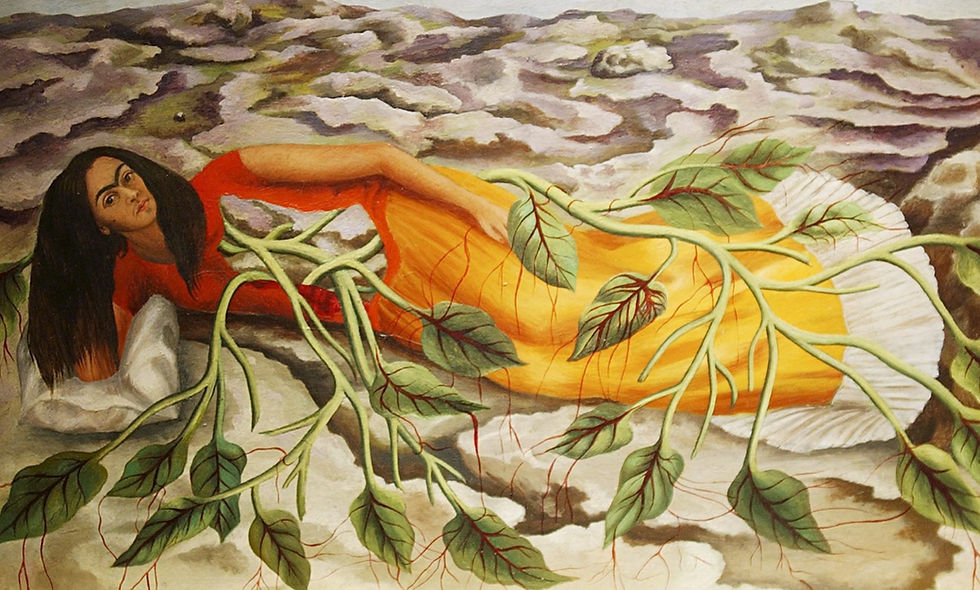Accident, disability, and art: Frida Kahlo and the desire to live
- Loredana Denicola

- Oct 3
- 6 min read
The life and art of Frida Kahlo are a powerful example of how pain, suffering, and personal challenges can be transformed into creativity and inner strength.
From her health struggles as a child to the bullying she endured for being different, Frida found in art a space to express complex emotions, process trauma, and communicate her uniqueness.
In art therapy, her experience becomes an invaluable guide: it shows us that physical and psychological scars do not have to limit personal growth but can become tools for expression, resilience, and emotional communication.
Her paintings demonstrate how pain can be transformed into colour, symbols, and narrative, offering concrete inspiration for anyone seeking to use art as a form of therapy and a path toward inclusion.

Frida Kahlo was born in Coyoacán on July 6, 1907.
She had a troubled life, marked by events that shaped her identity and her art.
She became disabled as a result of the event that most profoundly affected her life: a serious accident.
In addition, as a child, she contracted polio, which left her right foot and leg very thin.
She eventually developed a limp and was nicknamed “Frida, Wooden Leg.”
She wrote:"At six years old I had polio. From then on, I remember everything very clearly. I spent nine months in bed. It all started with a terrible pain in my right leg, from the thigh down. They washed my leg in a basin with walnut water and warm cloths. The leg remained very thin. By the age of seven, I wore little boots. At first, I thought the teasing would not affect me, but then it hurt, more and more intensely."
Bullying and acts of aggression among adolescents were clearly present even at that time.
"These issues prevent young people from fully and positively experiencing school life, as their experiences - both in school and in family or social contexts - are often marked by difficulties and distress. Both the child with a disability and the bully can develop positive and constructive relationships. The bully is not seen solely as a destructive subject, but, if placed in a regulated context based on healthy relationships, can become a protagonist of positive pathways toward peers with disabilities."
Frida Kahlo’s Accident: A Traumatic Turning Point
Returning to the accident: on September 17, 1925, at 18 years old, Frida’s life was drastically changed. Curious and active by nature, she was returning home from school on a bus with Alejandro Gómez Arias, a law student and journalist whom she had fallen in love with.
The bus collided with a tram, and Frida suffered severe injuries.
The vehicle was crushed against a wall, and she sustained life-altering damage: her spine fractured in three places in the lumbar region; her femur neck was shattered; her ribs were broken; her left leg suffered eleven fractures; her right foot was crushed and dislocated; her left shoulder dislocated; and her pelvis fractured in three places.
Additionally, a handrail penetrated her side and exited through her pelvic area.

Throughout her life, she underwent 32 surgeries.
She recalled:"The tram crushed the bus against the corner of the street. It was a strange impact: it was not violent, but dull, and everyone came out badly injured. I more than anyone else.
"Beyond the pain that can be felt just by reading about the consequences of her accident, Frida Kahlo was forced into years of solitude. After being discharged from the hospital, she had to remain in bed for years, wearing a plaster corset.
From this moment on, Frida turned her immobility into an opportunity.
This condition pushed her not only to read books on the communist movement but also to pursue what would become her raison d’être: painting.
Her family gifted her a canopy bed, paints, and a mirror positioned on the ceiling.
After completing her first painting, which depicted her beloved, she began producing a series of self-portraits:
"I paint myself because I am so often alone and I am the subject I know best."
Frida Kahlo before the accident had already experienced deep solitude, but she made art her only window to the world. Once she regained mobility, she would carry with her for life the intense pain caused by the accident - not only physical, but moral: depression, estrangement, loss, and the betrayals of her future husband Diego Rivera, including his affair with her sister, as well as the fact that she would never be able to have children, something she intensely desired.
Medical Technology and Art as a Response
In 1944, she had to wear a steel corset due to her spinal problems. Medical technology for disability at the time was much more rudimentary compared to today: while it solved certain issues, it could also cause physical and psychological discomfort.
This period inspired one of her most famous paintings, The Broken Column.
From 1951, she began using a wheelchair.
Also in 1944, she began keeping a personal diary, which she maintained until her death.
It was a sort of inner monologue expressed through words and images. For many illustrations, she started from an inkblot or a line, as if using automatism to examine her neuroses. A few years before her death, her right leg was amputated due to gangrene.
She died young, at 47, from a pulmonary embolism.
Her art was characterised by an obsessive relationship with her battered body, forced for years into immobility - nothing would ever be the same.

Art as Therapy
Unlike other famous disabled individuals whose struggles are often romanticised, Frida channeled her pain into her artistic creations. Through the motivation to live that art provided, she alleviated her suffering.
Art became a mental diversion from trauma, which repeatedly reappeared in her colourful paintings. Despite the hardships, she retained a sense of living in the moment.
This personal experience anticipates what we now know as art therapy: using artistic creation as a tool for care, expression, and liberation.
Art therapy helps people express difficult emotions, process trauma, and build resilience. In schools, hospitals, and rehabilitation centers, it becomes a valuable resource, just as it was for Frida within her room.

However, the value of Frida’s experience goes beyond individual therapeutic benefits: her life stands as a model of resilience and courage.
By showing how pain can be transformed into artistic creation, Frida offers a concrete example for those facing physical, emotional, or social challenges. Her self-portraits, diaries, and ability to continue living and producing despite immense suffering become sources of inspiration and motivation: observers can understand that limitations and injuries, when faced with creativity and determination, do not prevent building meaning and beauty in life.
Moreover, sharing Frida’s life helps others develop empathy and awareness: students, patients, or anyone experiencing vulnerability can see reflected in her experience the possibility to react to pain, find their voice, and build new forms of expression.
In this way, art and storytelling become tools not only for processing trauma but also for emotional education, social inclusion, and valuing diversity.
Bullying, Disability, and Art as Inclusion
Frida Kahlo’s journey shows how physical difficulties intertwine with social challenges: even as a child, she was mocked for having polio. Bullying, then as now, weighs heavily on the development of those who live with difference.
In today’s society, episodes of exclusion, teasing, or discrimination can have deep effects on young people’s psychological well-being.
Frida’s experience becomes, therefore, a positive model: it shows how it is possible to respond to adversity by transforming pain into something creative and meaningful.
Art can offer a space for connection and expression: shared artistic activities help develop empathy, understand others’ perspectives, and turn acts of domination into opportunities for relationship. Even the bully can become, if guided, part of a positive journey alongside peers with disabilities.
From Frida’s life, young people can learn that difficulties and moments of isolation do not have to limit their growth: it is possible to respond with creativity, passion, and resilience, finding ways to express oneself and build positive relationships.
Artists and anyone experiencing moments of despair can draw inspiration from her life: scars and suffering are not only obstacles but also sources of expression, tools for personal growth, and opportunities to communicate deep emotions to others. In this sense, Frida becomes a universal example of how pain can be transformed into art, resilience, and the ability to positively influence those around us.

The Lesson of Frida Kahlo
Frida continued to paint until the end, despite amputations, excruciating pain, and increasingly severe difficulties. She never hid her wounds: she transformed them into colour, into symbols, into universal art.
Her legacy is not only that of an extraordinary painter, but of a woman who taught the world how to endure pain by turning it into a creative language.
Her true lesson is this: to live fully despite adversity, to make fragility a strength, and to find in art and relationships a reason to continue seeking the beauty of life.
"What pain or difficulty in your life could you transform into creativity, like Frida Kahlo did?"
"How can you use art to express what you feel inside, just as Frida did with her pain?"
"Which part of your uniqueness could you turn into strength and beauty through creativity?"
by Loredana





Comments